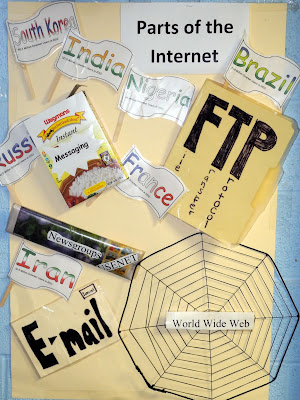In 6th grade we get “connected” to and learn how many users connect to the Internet around the world. This activity is really fun and I would love to share it with you!
What you need:
- Yarn
- Popsicle sticks
- These flags here- Please note that this is a Word Document that you can go back and edit when new stats are @ http://www.internetworldstats.com/top20.htm
- Glue, tape and laminate to protect those flags!
- Optional: See props in photo below.
What you do:
 |
| Props for teaching 6th Graders the Internet |
- Prep: Cut out each flag, laminate and attach them to the popsicle stick for durability.
- Introduce the Internet and its definitions. I typically use a PowerPoint to do this, or you can find many resources online (such as http://www.internet101.org/).
- If your computer lab permits, have your students disperse themselves throughout the room. I started with the states within the U.S. with the students closest together in the center of the room. Hand the first student a state flag (I did smallest amount of users to largest) and ask him/her to read aloud the state and number of Internet users. Then give that student the end of the yarn.
- Go to the next student and hand them the next state flag. Have them read aloud the state and the number of people connected to the Internet. “Connect” this student to the first user (string the piece of yarn to them with the first person still holding on). If you need to, please request that students are careful not to tangle themselves within the yarn as it can be a strangling matter!
- Continue this process until all the state flags are distributed. Make sure to “connect” the students to each other with the yarn. The yarn helps them understand how everyone is connected to one another.
- Then move onto the countries, making the same connections. Once everyone is connected, I made props (shown in the photo above) and tossed them onto the ‘connected’ Internet to illustrate how these elements (World Wide Web, FTP, Newsgroups, Instant Messaging and email) are a part of the Internet.
- Collect all materials and discuss.
I would love to know how your lesson goes!